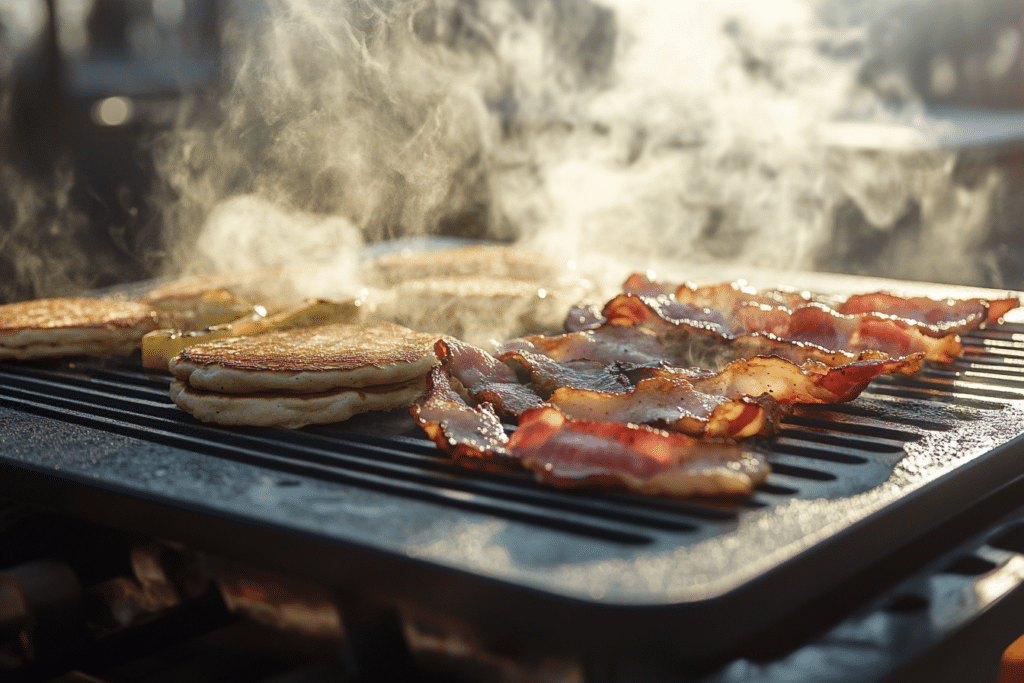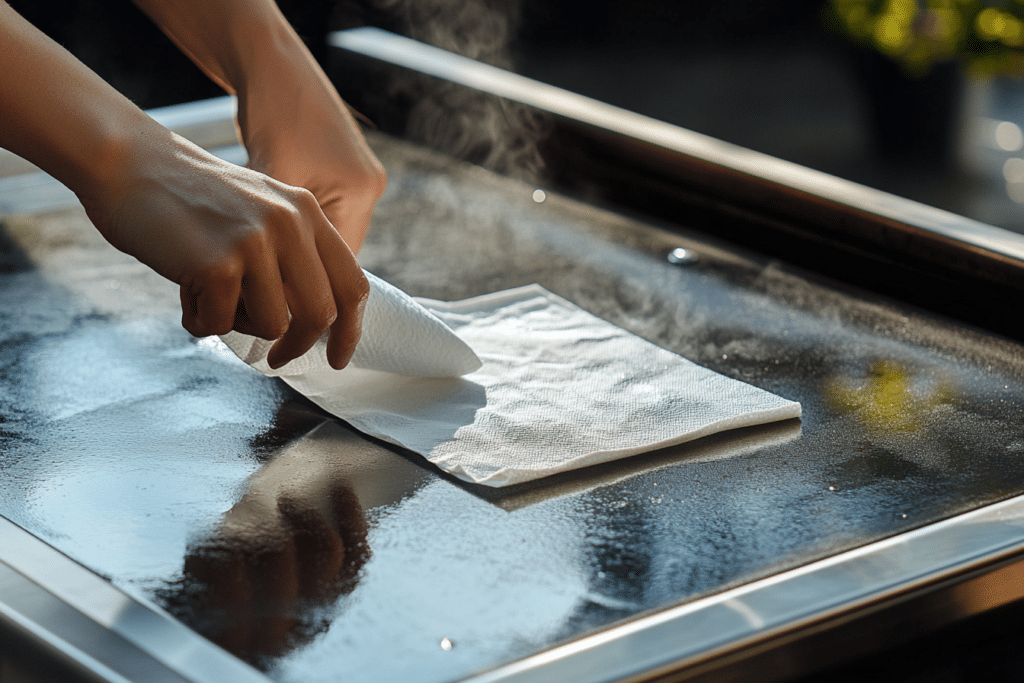Introduction
The Blackstone griddle has become a popular choice for outdoor cooking enthusiasts thanks to its versatility and ease of use. Whether you’re making a hearty breakfast, sizzling burgers, or stir-fried veggies, it delivers exceptional results. However, improper usage can lead to issues such as surface damage, poor cooking outcomes, and even safety hazards.
Understanding what not to do on a Blackstone griddle is crucial to prolong its lifespan and get the most out of your investment. This guide outlines the most common mistakes, explains how to avoid them, and provides expert tips to ensure your cooking experience is seamless and enjoyable.
1. Common Mistakes: What Not to Do on a Blackstone Griddle
Even experienced cooks can make errors when using a Blackstone griddle. By recognizing these pitfalls, you can enhance your cooking outcomes and prevent unnecessary damage.
1.1. Why Overheating Is What Not to Do on a Blackstone Griddle

Excessively high heat can cause irreparable damage to the griddle’s surface. When you use high temperatures for extended periods, the surface may warp, and the seasoning layer can burn off. To learn about the best dishes to cook while maintaining optimal heat, check out our guide on Top Dishes to Cook on a Blackstone Griddle.
1.1.1. Signs of Overheating
- Smoke rising excessively from the griddle surface.
- Uneven cooking or hot spots on the griddle.
- A burnt appearance on the food despite a short cooking time.
How to Avoid: Preheat the griddle on medium heat instead of maxing out the temperature. For searing meats, allow the griddle to warm up gradually.
1.2. What Not to Do on a Blackstone Griddle: Avoid Low Smoke-Point Oils
Not all oils are created equal, especially when cooking on a griddle. Low smoke-point oils like olive oil tend to burn quickly, leaving behind a sticky residue that can ruin your food.
Recommended Oils: Stick to high smoke-point oils such as avocado oil, canola oil, or sunflower oil for optimal results.
Tip: Pour the oil sparingly and spread it evenly using a silicone brush or paper towel to avoid excessive buildup. To learn more about the best oils for cooking and their unique properties, visit The Science Behind Cooking Oils.
1.3. Neglecting Proper Preheating
Skipping the preheating step often results in unevenly cooked food. Foods like pancakes or burgers can end up burnt on one side and undercooked on the other.
How to Preheat:
- Turn on the griddle and set it to medium heat.
- Wait for 8–10 minutes. Sprinkle a few drops of water on the surface; if they sizzle and evaporate, your griddle is ready.
1.4. Overcrowding the Surface
It might seem tempting to fill every inch of the griddle with food, but overcrowding prevents proper airflow and heat distribution. As a result, food may steam instead of sear.
Solution: Cook in smaller batches to give each item enough room to caramelize properly. This ensures crisp textures and consistent cooking.
1.5. Ignoring the Cooking Zones
Blackstone griddles are designed with different heat zones, allowing you to cook various items simultaneously. However, failing to utilize these zones can result in overcooked or undercooked food.
How to Use Cooking Zones:
- Use high heat for quick-searing meats.
- Medium heat works well for vegetables or sandwiches.
- Low heat zones are perfect for keeping cooked food warm.
2. Maintenance Mistakes: What Not to Do on a Blackstone Griddle
Proper maintenance of your Blackstone griddle is essential for both its longevity and performance. Many users unknowingly commit maintenance errors that lead to rust, a damaged cooking surface, or inconsistent results.
2.1. Forgetting Seasoning: What Not to Do on a Blackstone Griddle
Seasoning your griddle isn’t just a one-time process—it’s an ongoing practice that keeps the surface non-stick and rust-resistant. Many users skip this crucial step, leading to sticking issues and surface degradation. For a variety of delicious dishes that benefit from a perfectly seasoned griddle, explore our Blackstone Recipes Guide.

2.1.1. Why Seasoning Matters
- Creates a natural non-stick layer.
- Prevents rust and corrosion.
- Enhances the flavor of your food over time.
Step-by-Step Guide to Seasoning:
- Clean the surface with mild soap (only for first-time seasoning).
- Apply a thin, even layer of high smoke-point oil.
- Heat the griddle until the oil begins to smoke.
- Repeat the process 2–3 times until the surface turns black and shiny.
2.2. Using Soap on the Cooking Surface
Soap is an effective cleaning agent for many kitchen tools, but it’s a mistake to use it on a griddle’s cooking surface. Soap strips away the seasoning layer, making the surface prone to rust and sticking.
Proper Cleaning Method:
- Use warm water and a scraper to remove food debris.
- Wipe the surface with a cloth or paper towel.
- Reapply a thin coat of oil after cleaning.
2.3. Storing the Griddle Improperly
Leaving your griddle exposed to the elements can lead to rust, which is difficult to remove and compromises the surface.
Best Practices for Storage:
- Use a weatherproof Blackstone cover to shield it from rain and moisture.
- Store the griddle in a garage or shed during extended periods of non-use.
Tip: Ensure the griddle is completely dry before covering it to prevent trapped moisture.
2.4. Using Harsh Cleaning Tools
Metal brushes or abrasive pads may seem effective, but they can scratch and damage the griddle’s surface. These scratches remove the seasoning and expose the metal to rust.
Recommended Tools:
- Use a griddle scraper for stuck-on food.
- Opt for non-abrasive sponges or soft scouring pads for daily cleaning.
2.5. Not Re-Oiling After Cleaning
After cleaning the griddle, many users forget to apply a thin layer of oil. This leads to a dry surface that is more susceptible to rust.
How to Re-Oil the Surface:
- Allow the griddle to cool slightly after cleaning.
- Apply a few drops of oil and spread it evenly with a paper towel.
- Wipe away excess oil, leaving only a thin, protective layer.
3. Cooking Practices: What Not to Do on a Blackstone Griddle for Perfect Results
Improper cooking practices can compromise both the quality of your food and the condition of your Blackstone griddle. By recognizing these mistakes, you can enhance your cooking experience and prevent unnecessary wear and tear.
3.1. Why Cooking Frozen Foods Is What Not to Do on a Blackstone Griddle
Placing frozen foods directly on the griddle may seem convenient, but it leads to uneven cooking and potential safety risks. The frozen items cause a sudden drop in surface temperature, disrupting the griddle’s heat distribution.
Why It’s a Problem:
- The exterior may cook while the interior remains raw.
- Frozen items can release excess water, causing splatter and steaming.
Solution: Always defrost foods thoroughly before placing them on the griddle.
3.2. Using Acidic Ingredients Without Protection
Acidic foods such as tomatoes, citrus juices, and vinegar can corrode the griddle surface over time if not managed carefully. These ingredients react with the metal, damaging the seasoning layer.
How to Avoid Damage:
- Use griddle-safe liners when cooking highly acidic dishes.
- Clean and re-season the surface immediately after cooking acidic foods.
3.3. Leaving Food Residue on the Griddle
Failing to clean your griddle after each cooking session allows food residue to harden, which can cause sticking and uneven heating the next time you cook.
Tips for Cleaning After Cooking:
- Scrape off food particles while the griddle is still warm.
- Use a damp cloth or water to wipe down the surface.
- Avoid letting grease or charred bits accumulate over time.
3.4. Forgetting to Use the Right Utensils
Using the wrong tools, such as metal spatulas with sharp edges, can scratch the griddle’s surface. Similarly, plastic utensils may melt if exposed to high heat. If you’re crafting a smash burger, pair it with a homemade topping like our Perfect Burger Sauce Recipe to elevate your meal.
Recommended Utensils:
- Opt for stainless steel spatulas with smooth edges or silicone tools.
- Avoid sharp or pointed utensils that can gouge the surface.
4. Safety Guidelines: What Not to Do on a Blackstone Griddle
Safety should always be a top priority when cooking with a Blackstone griddle. Avoiding these common safety mistakes will protect you, your equipment, and those around you.
4.1. Not Using the Griddle on a Stable Surface
Setting up your griddle on an uneven or unstable surface increases the risk of accidents. A wobbling griddle can lead to spills, burns, and even tipping over during use.
Tips for Stability:
- Always place the griddle on a level, heat-resistant surface.
- Ensure the legs or stand are locked securely.
4.2. Cooking Without Proper Ventilation
Using a griddle in enclosed spaces, such as garages or indoor areas, can lead to dangerous carbon monoxide buildup. Propane-fueled griddles require adequate airflow for safe operation.
How to Ensure Ventilation:
- Always use your griddle outdoors or in a well-ventilated area.
- Avoid cooking near walls or objects that block airflow.
For comprehensive tips on safe outdoor cooking practices, refer to this Safe Outdoor Cooking Practices guide.
4.3. Ignoring Grease Management

The grease trap on a Blackstone griddle collects excess oil and food drippings. If left unchecked, this grease can overflow or catch fire, posing a serious safety hazard.
Grease Management Tips:
- Empty the grease trap after every cooking session.
- Regularly inspect the trap for clogs or buildup.
- Use a heat-resistant container to dispose of grease safely.
4.4. Leaving the Griddle Unattended
Cooking on high heat and leaving your griddle unattended is a recipe for disaster. Food can burn, and grease flare-ups can escalate quickly when no one is monitoring the cooking process.
Safe Cooking Practices:
- Keep a close eye on the griddle at all times.
- If you need to step away, turn off the burners and allow the griddle to cool.
5. Expert Tips for Avoiding Blackstone Griddle Mistakes
To maximize your Blackstone griddle experience, learning from common pitfalls and implementing expert tips is key. These strategies will help you cook efficiently, maintain your griddle, and ensure safety.
5.1. Planning Your Cooking Session
Preparation is essential for a smooth cooking process. Many mistakes, such as overcrowding or burning food, stem from poor planning.
How to Plan Effectively:
- Pre-chop and measure all ingredients before heating the griddle.
- Arrange ingredients based on their cooking times, placing longer-cooking items on the griddle first.
- Keep necessary tools like spatulas, oil, and scrapers within reach.
5.2. Using the Right Tools for the Job
The tools you use can make or break your griddle-cooking experience. Choosing the right utensils ensures your food cooks properly and your griddle remains in excellent condition.
Essential Tools:
- Spatulas: Look for flat, wide spatulas that can handle large portions.
- Oil Dispensers: Use squeeze bottles for precise oil application.
- Thermometers: Instant-read thermometers help monitor meat temperatures.
- Scrapers: Soft-edge scrapers help remove residue without scratching.
5.3. Practicing Regular Maintenance
Consistent maintenance is vital for preserving your griddle’s functionality and appearance. Skipping routine care can lead to performance issues and shorten its lifespan.
Quick Maintenance Checklist:
- Clean the griddle after every use.
- Re-season the surface regularly to maintain its non-stick coating.
- Store the griddle in a covered, dry area to prevent rust.
6. FAQs About What Not to Do on a Blackstone Griddle
Here are answers to some frequently asked questions to help you avoid common mistakes and maximize your Blackstone griddle experience.
6.1. Can I Use Butter on My Blackstone Griddle?
Using butter directly on the griddle is not recommended because it has a low smoke point and can burn quickly, leaving behind a sticky residue. Instead, use high smoke-point oils like avocado or canola oil. If you want the flavor of butter, add it at the end of cooking or mix it with oil to raise its smoke point.
6.2. How Often Should I Re-Season My Griddle?
It’s best to re-season your griddle after every deep cleaning or if you notice food sticking to the surface. Regular seasoning reinforces the non-stick layer and prevents rust.
Tip: After each use, apply a light coat of oil to maintain the seasoning.
6.3. Can I Leave My Griddle Outside Uncovered?
Leaving your griddle outside without proper protection is a major mistake. Exposure to moisture can lead to rust, which is difficult to remove.
Solution: Always cover your griddle with a weatherproof Blackstone cover or store it in a dry area.
6.4. What Should I Do If Food Sticks to the Surface?
If food sticks to the griddle, it’s likely due to insufficient seasoning or improper cleaning. Scrape off the stuck food with a griddle scraper, clean the surface, and re-season before your next use.
Conclusion
Avoiding mistakes on your Blackstone griddle not only ensures better cooking outcomes but also prolongs the lifespan of your equipment. By following these guidelines, you can prevent common issues, improve safety, and enjoy the full versatility of your griddle. Whether you’re a beginner or a seasoned griddle master, adopting these practices will elevate your outdoor cooking experience.
